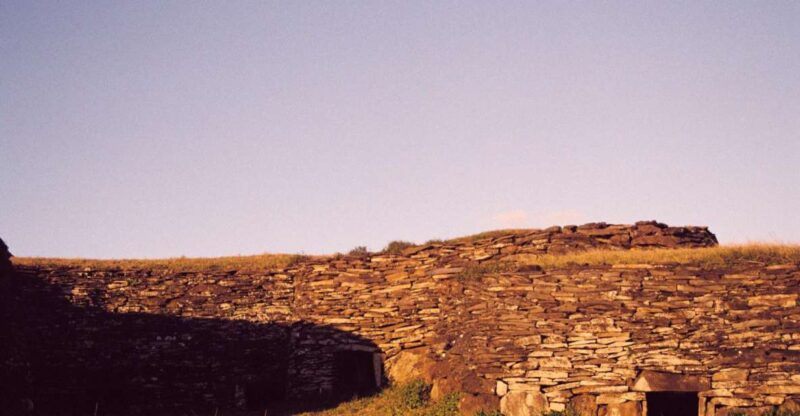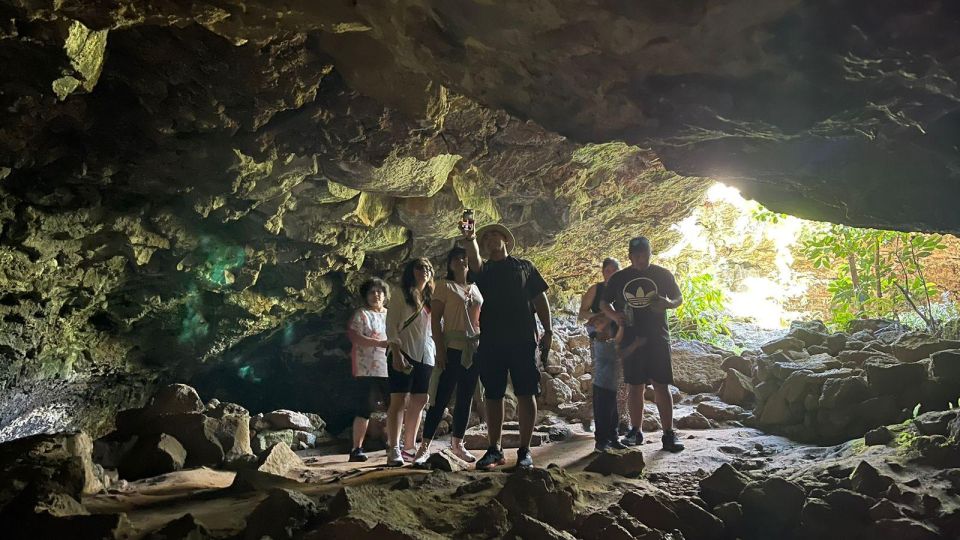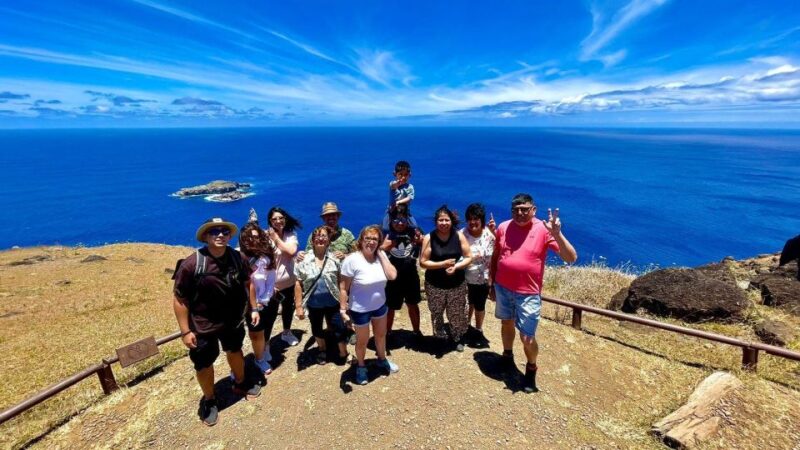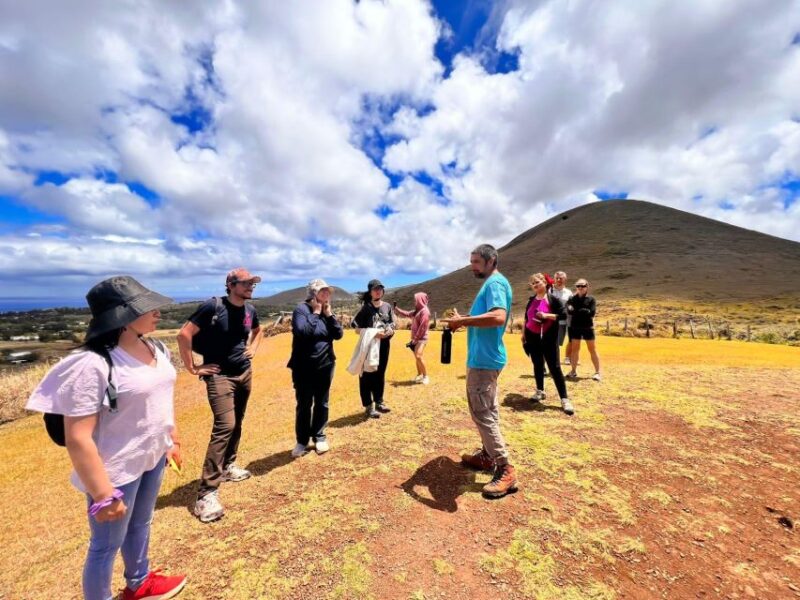The Birdman Cult, an intriguing aspect of Rapa Nui culture, revolves around the intense competition for sooty tern eggs, a practice steeped in both physical challenge and spiritual significance. Caves like Ana Te Pahu and Orongo stand as testament to this tradition, housing ancient petroglyphs that narrate the island’s complex history and its people’s connection to the land. As one explores these sacred spaces, the interplay between the cult and these geological wonders raises compelling questions about belief, ritual, and the environment. What secrets might these caves still hold?
Key Points

- The Birdman Cult, or Tangata Manu, involved retrieving sooty tern eggs from cliffs, highlighting bravery and spirituality in Rapa Nui culture.
- Caves like Ana Te Pahu served as sacred spaces for rituals, showcasing the spiritual connection between the Rapa Nui people and their environment.
- Petroglyphs found in the caves illustrate the vibrant history and mythology tied to the Birdman cult, enriching cultural understanding.
- Orongo Village, a key site for the Birdman cult, features petroglyphs and ceremonial areas that reflect the community’s traditions and beliefs.
- The natural rock formations of caves contribute to a mystical ambiance, enhancing the experience of exploring Rapa Nui’s cultural heritage.
Overview of the Birdman Cult

The Birdman Cult, a fascinating aspect of Easter Island’s cultural heritage, revolved around a unique competition that celebrated the islanders’ connection to the sea and their spiritual beliefs.
Each year, tribes would compete to retrieve the first egg laid by the sooty tern from the nearby islet of Motu Nui. This contest, known as the Tangata Manu, symbolized not just physical prowess but also the islanders’ deep respect for nature.
The winning tribe’s leader would gain prestige and power, reinforcing their social structure. Participants would climb treacherous cliffs and brave ocean currents, showcasing their bravery and skill.
The Birdman Cult, rich in symbolism and tradition, reflects the island’s unique blend of spirituality, competition, and community bonding that defined the ancient Rapa Nui people.
You can also read our reviews of more tours and experiences in Orongo.
Historical Significance of Caves

Caves on Easter Island hold a treasure trove of historical significance, serving as sacred spaces where ancient rituals and community gatherings took place. These caves offer a glimpse into the spiritual lives of the island’s inhabitants, showcasing their connection to the environment and the divine.
| Cave Name | Key Features | Cultural Importance |
|---|---|---|
| Ana Te Pahu | Petroglyphs and paintings | Rituals and ancestral worship |
| Rano Kau | Volcanic crater | Source of fresh water |
| Orongo | Birdman cult site | Ceremonial gatherings |
Ahu Akivi and Its Moais

Ahu Akivi stands out as a remarkable site on Easter Island, showcasing seven moais that have captivated visitors with their celestial alignment and cultural significance.
Positioned inland, these statues uniquely face the ocean, a contrast to most others on the island. This orientation sparks curiosity about their purpose, believed to be linked to navigation and ancestral worship.
Each moai carries a story, representing the island’s rich heritage and the artistry of its creators. Visitors often find themselves enchanted by the serene atmosphere surrounding Ahu Akivi, as they ponder the mysteries of the past.
With knowledgeable guides sharing insights, exploring this site offers a deeper appreciation for the cultural legacy that these iconic figures embody in the heart of Easter Island.
The Ceremonial Cave of Ana Te Pahu

Visitors to Easter Island also marvel at Ana Te Pahu, a ceremonial cave rich with petroglyphs and paintings that vividly illustrate the island’s vibrant history and cultural traditions. As they explore this fascinating site, they’re often struck by:
-
Intricate carvings of mythical birds, symbols of the birdman cult
-
Colorful depictions of ancient rituals and ceremonies
-
Worn paths that echo the footsteps of past worshippers
-
Natural rock formations that create a mystical ambiance
-
Echoes of the ocean waves that enhance the cave’s serene atmosphere
Each detail in Ana Te Pahu tells a story, connecting visitors to the island’s ancestral roots and offering a glimpse into the spiritual practices that once thrived here.
It’s a must-see for anyone seeking to understand Easter Island’s rich heritage.
More Great Tours NearbyThe Puna Pau Quarry
Nestled in the heart of Easter Island, the Puna Pau quarry reveals the remarkable craftsmanship behind the iconic red scoria topknots that adorned the island’s moais. This quarry, a vital site for ancient artisans, showcases their skill in carving and shaping the materials. Visitors often marvel at the quarry’s unique formations while learning about the cultural significance of these topknots.
| Aspect | Details |
|---|---|
| Type of Stone | Red Scoria |
| Primary Use | Topknots for Moais |
| Artisan Techniques | Carving, Shaping |
| Historical Significance | Cultural Identity of Rapa Nui |
Exploring Puna Pau offers a deeper understanding of the island’s heritage and the dedication of its people in creating these monumental statues.
Insights Into Vinapu Architecture
Vinapu architecture showcases impressive megalithic structures that reflect the advanced engineering skills of the Rapa Nui people and their historical connections to South American cultures. Visitors are often captivated by the intricate stonework and the precision with which these massive blocks fit together.
-
Massive, tightly-fitted stones that seem to defy gravity
-
Smooth surfaces that glisten under the sun
-
Ancient platforms that hold secrets of a lost civilization
-
Intricate carvings whispering tales of the past
-
A breathtaking backdrop of lush greenery and azure skies
These elements create a sense of wonder, inviting exploration and contemplation.
The Vinapu site stands as a testament to the ingenuity of its creators, highlighting a rich cultural heritage that continues to intrigue researchers and travelers alike.
Exploring Orongo Village

Orongo Village offers a fascinating glimpse into the birdman cult, where ancient rituals and stunning views of the Pacific Ocean intertwine to create a unique cultural experience.
Visitors walk among the remnants of stone houses and ceremonial sites, seeing a world where the islanders once competed for the title of birdman. The petroglyphs carved into the cliffs tell stories of this intriguing tradition, showcasing the island’s rich spiritual heritage.
As they explore, travelers can’t help but feel a connection to the past. The panoramic views from Orongo are breathtaking, providing a perfect backdrop for reflection.
In this sacred place, history and nature unite, leaving visitors with a deeper appreciation for Easter Island’s vibrant culture.
Natural Beauty of Rano Kau
The stunning volcanic crater of Rano Kau captivates visitors with its lush greenery and unique ecosystems, showcasing the natural beauty that defines Easter Island.
As they explore this breathtaking landscape, they often find themselves enchanted by:
-
Vibrant wildflowers swaying gently in the breeze
-
Towering cliffs that plunge dramatically into the ocean
-
A serene lagoon filled with native birds and aquatic life
-
Ancient stone formations whispering tales of the past
-
Panoramic views of the rugged coastline and endless blue sky
Rano Kau’s diverse flora and fauna offer a glimpse into the island’s rich ecological tapestry.
This natural wonder not only enriches the visitor experience but also deepens their appreciation for the island’s geological history and the delicate balance of its environment.
Frequently Asked Questions
What Was the Primary Purpose of the Birdman Cult?
The primary purpose of the birdman cult was to establish a connection between the divine and earthly realms. Participants sought favor from the gods through competitions, emphasizing strength and bravery, while ensuring community cohesion and cultural identity.
How Did the Birdman Cult Influence Local Traditions?
The birdman cult significantly shaped local traditions, intertwining spiritual beliefs with community rituals. It fostered a unique cultural identity, influencing art, ceremonies, and social hierarchies, ensuring its lasting impact on Easter Island’s heritage and practices.
Are There Any Myths Associated With the Birdman Cult?
Many myths surround the birdman cult, often highlighting themes of transformation and divine connection. These stories reflect the islanders’ beliefs about nature, spirituality, and the crucial role birds played in their cultural identity and rituals.
What Artifacts Are Found in the Ceremonial Caves?
Visitors often discover fascinating artifacts in ceremonial caves, like ancient petroglyphs and vibrant paintings. These relics showcase the island’s rich history, revealing stories of its past inhabitants and their cultural practices, sparking curiosity and admiration.
How Did the Birdman Cult Affect Easter Island’s Social Structure?
The birdman cult reshaped Easter Island’s social structure by establishing a competitive hierarchy. Leaders emerged through challenges, fostering alliances and rivalries, which influenced resource allocation and community organization, ultimately defining societal roles for generations.
Recap
The Birdman Cult and its sacred caves reveal a captivating blend of competition, spirituality, and reverence for nature among the Rapa Nui people.
As they scaled cliffs for sooty tern eggs, they forged a profound connection to their land.
From the ancient petroglyphs in Ana Te Pahu to the architectural wonders of Vinapu, every site tells a story.
Exploring this rich heritage invites a deeper appreciation for the resilience and culture of the Rapa Nui, making their legacy truly unforgettable.
You can check availability for your dates here: